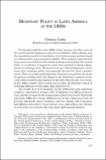| dc.contributor.author | Corbo, Vittorio | |
| dc.date.accessioned | 2019-11-01T00:01:14Z | |
| dc.date.available | 2019-11-01T00:01:14Z | |
| dc.date.issued | 2002 | |
| dc.identifier.isbn | 956-7421-099 | |
| dc.identifier.uri | https://hdl.handle.net/20.500.12580/3654 | |
| dc.description | For decades until the early 1990s, Latin America was the region of the world with the highest average level of inflation. High inflation was the cumulative result of a long history of activist economic policies based on a disregard for macroeconomic stability. These policies culminated in large government deficits that ended up being monetized by the central bank, or in balance of payments crises that resulted in sharp adjustments in exchange rates. | |
| dc.format | .pdf | |
| dc.format.extent | Sección o Parte de un Documento | |
| dc.format.medium | p. 117-165 | |
| dc.language.iso | eng | |
| dc.publisher | Banco Central de Chile | |
| dc.relation.ispartof | Serieson Central Banking, Analysis, and Economic Policies, no. 4 | |
| dc.rights | Attribution-NonCommercial-NoDerivs 3.0 Chile | * |
| dc.rights.uri | http://creativecommons.org/licenses/by-nc-nd/3.0/cl/ | * |
| dc.subject | POLÍTICA MONETARIA | es_ES |
| dc.subject | INFLACIÓN | es_ES |
| dc.subject | BANCOS CENTRALES | es_ES |
| dc.subject | TIPO DE CAMBIO | es_ES |
| dc.subject | BALANZA DE PAGOS | es_ES |
| dc.title | Monetary policy in Latin America in the 1990s | |
| dc.type.doc | Artículo | |
| dc.file.name | BCCh-sbc-v04-p117_166 | |


